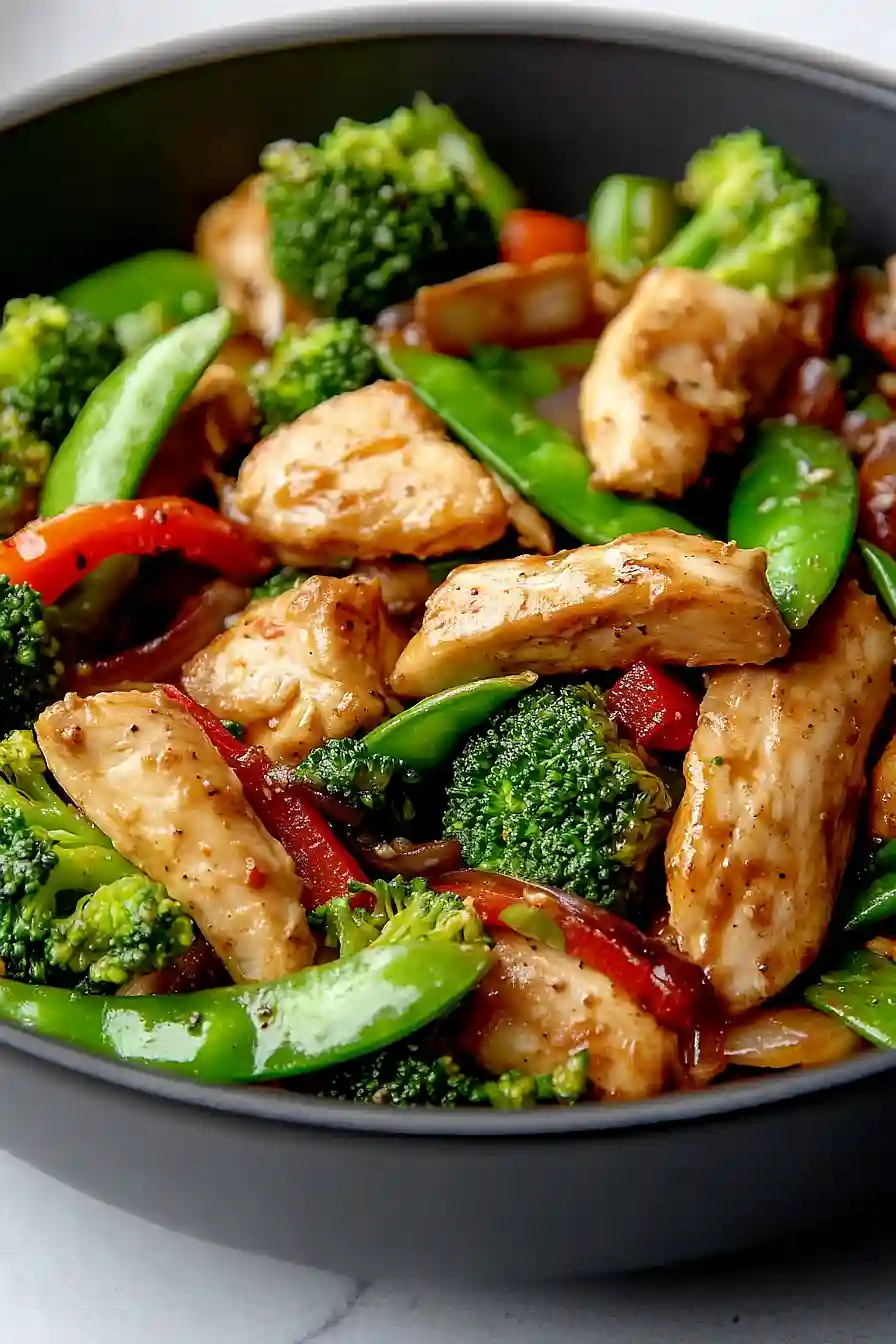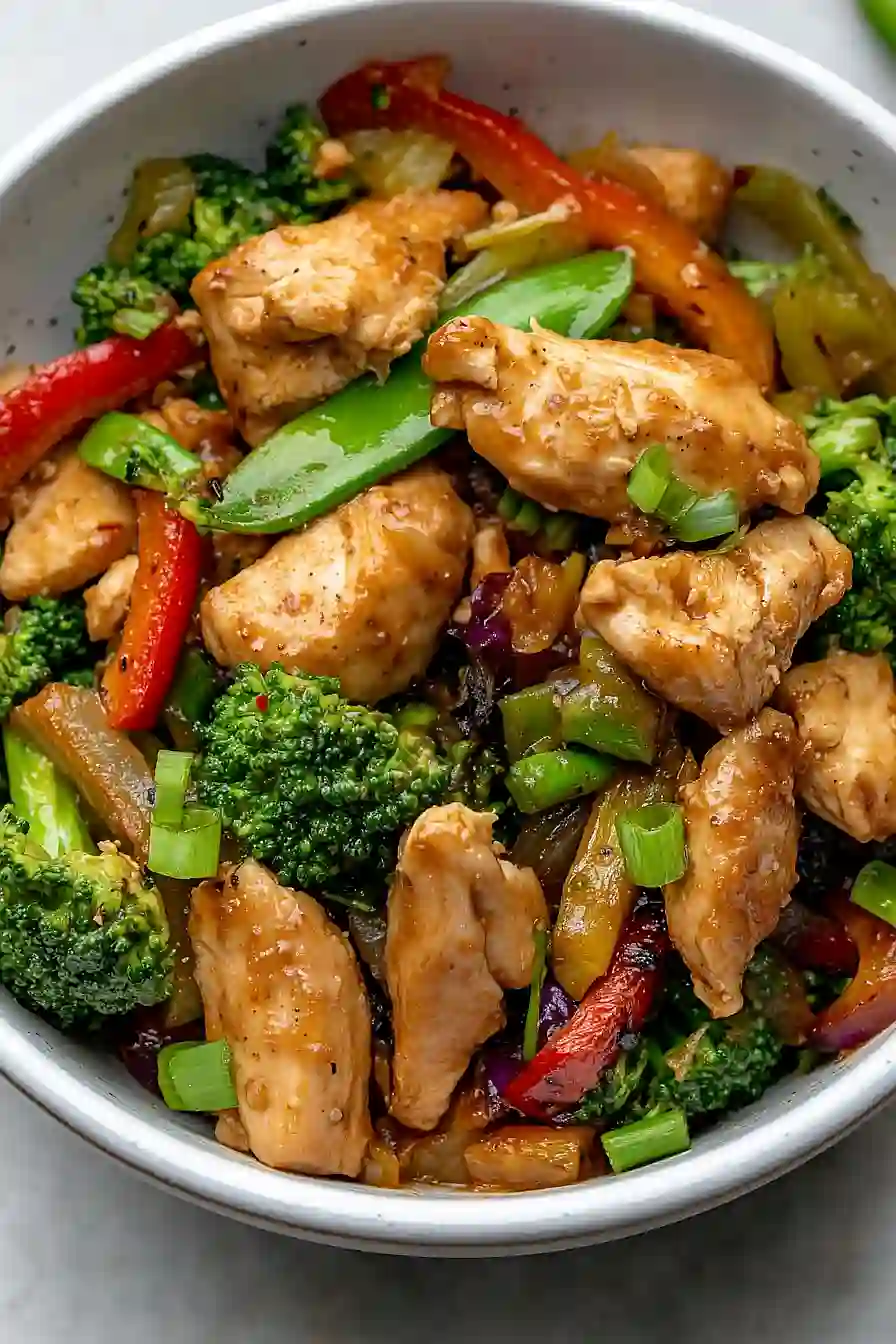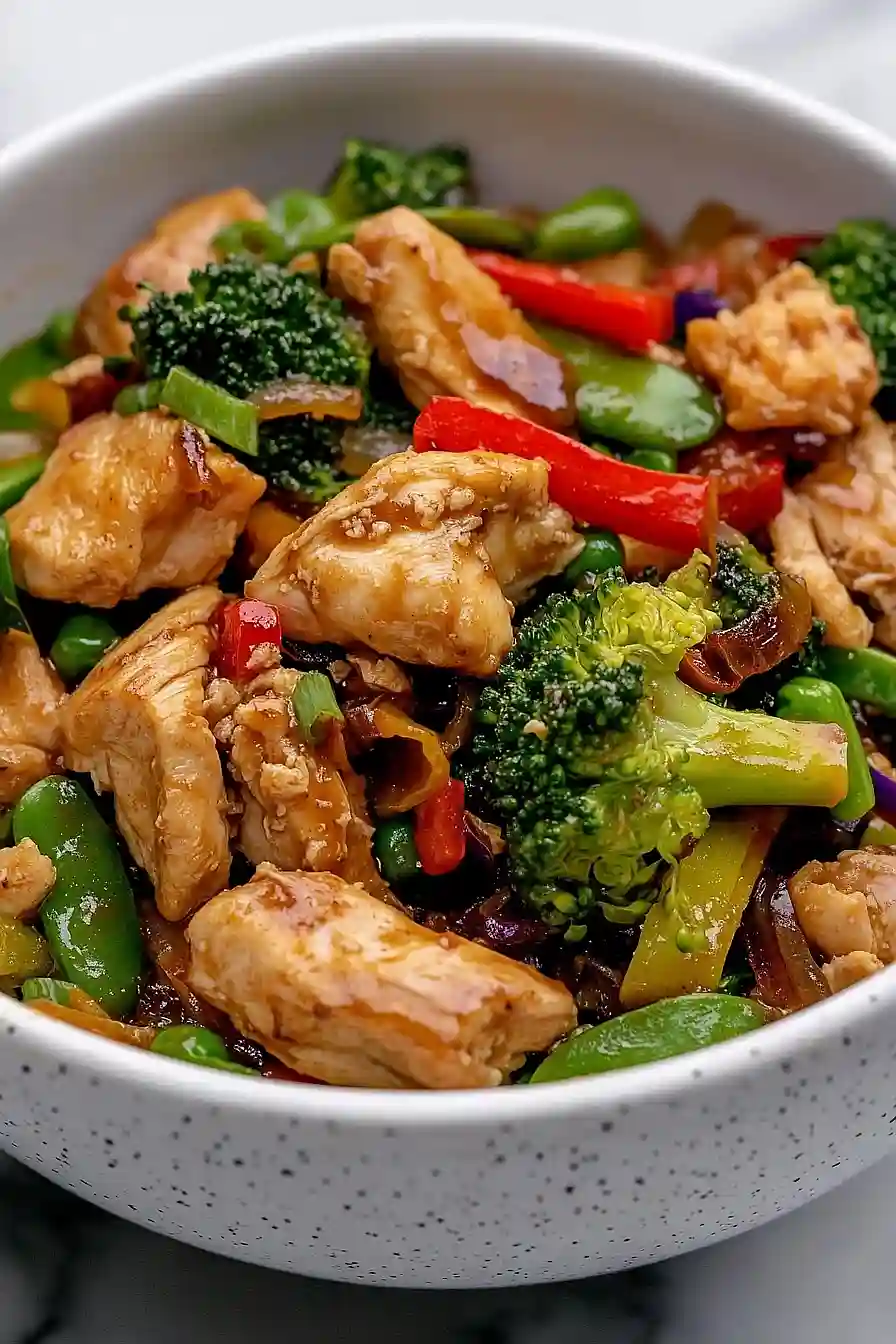Disclaimer: Our editors have used AI to create or enhance parts of this article. All content has been fact-checked by our team to ensure accuracy.
When I first started eating paleo, I thought stir-fries were off the menu because of all those store-bought sauces filled with sugar and soy. That’s how my mom always made them, and I couldn’t imagine a stir-fry without that sweet-and-salty sauce from a bottle.
Turns out, I was totally wrong about needing those packaged sauces. With just a few simple ingredients and some fresh vegetables, you can make a stir-fry that’s not only paleo-friendly but actually tastes better than the takeout version. And the best part? It’s ready in less time than it takes to get delivery.

Why You’ll Love This Chicken Stir Fry
- Quick preparation – Ready in just 20-30 minutes, this stir fry is perfect for those busy weeknights when you need a fast but satisfying meal.
- Diet-friendly – This paleo-compliant recipe fits perfectly into a grain-free, dairy-free lifestyle while still delivering amazing flavor with its date-sweetened sauce.
- Packed with vegetables – With broccoli, bell peppers, snow peas, and cabbage, you’ll get plenty of nutrients and fiber in every colorful serving.
- Clean ingredients – Using simple, whole-food ingredients like coconut aminos instead of soy sauce and bone broth for extra nutrition, this recipe keeps things natural and healthy.
- Customizable – You can easily swap in different vegetables based on what you have on hand, making this a flexible option for using up produce in your fridge.
What Kind of Chicken Should I Use?
For stir-frying, chicken thighs are actually a better choice than chicken breasts because they stay more tender and juicy during the high-heat cooking process. Dark meat is more forgiving and won’t dry out as quickly as breast meat, making it perfect for beginners who are just learning to stir-fry. If you’re buying your chicken thighs from the store, both boneless skinless or bone-in will work, though boneless skinless saves prep time since they’re ready to slice and cook. Just make sure to cut your chicken pieces uniformly – about 1 inch in size – so they cook evenly in the pan.

Options for Substitutions
This paleo stir fry is pretty adaptable and you can make several swaps while keeping it paleo-friendly:
- Medjool date: If you don’t have dates, you can use 1 tablespoon of honey or maple syrup to add natural sweetness. Just make sure to check that this fits your dietary needs.
- Coconut aminos: While coconut aminos are the paleo substitute for soy sauce, you can use tamari if you’re not strictly paleo. Note that tamari is stronger, so start with half the amount.
- Tapioca/arrowroot starch: These starches are interchangeable in this recipe. If you’re not following paleo, cornstarch works too – use the same amount.
- Chicken thighs: You can swap in chicken breast if you prefer, just be careful not to overcook it as it can dry out more quickly than thighs. Cut the pieces slightly larger.
- Vegetables: The great thing about stir-fries is that you can mix and match vegetables. Try snap peas instead of snow peas, cauliflower instead of broccoli, or add mushrooms and carrots. Just keep the total amount of veggies about the same.
- Bone broth: Regular chicken broth works fine here, or you can use vegetable broth. If using regular broth, you might want to reduce the salt in your seasoning.
Watch Out for These Mistakes While Cooking
The biggest challenge when making stir-fry is overcrowding your pan, which causes the vegetables to steam instead of getting that perfect crispy-tender texture – work in batches if needed and keep your pan hot. Another common mistake is not prepping all ingredients before starting to cook, since stir-frying moves quickly and requires immediate attention once you begin. Adding the sauce too early can make your chicken and vegetables soggy, so make sure to cook the meat and vegetables first until they’re almost done, then add the sauce mixture in the final minutes of cooking. For the best results, cut all your vegetables in similar-sized pieces to ensure even cooking, and don’t forget to let your chicken pieces come to room temperature before cooking to prevent them from releasing excess moisture into the pan.

What to Serve With Chicken Stir Fry?
Since this paleo stir fry is already packed with protein and vegetables, you’ll want to focus on simple sides that complement without overwhelming the dish. Cauliflower rice makes a perfect grain-free base – just sauté it with a little coconut oil and salt to soak up all that tasty sauce. For extra crunch and flavor, you might want to add some chopped cashews or sliced almonds on top. If you’re really hungry, a side of simple cucumber salad dressed with rice vinegar adds a cool, refreshing element that pairs nicely with the warm stir fry.
Storage Instructions
Keep Fresh: This stir fry is perfect for meal prep! Place it in an airtight container and keep it in the fridge for up to 4 days. The flavors actually get better as they meld together, making your leftovers extra tasty.
Pack: For lunch prep, portion the stir fry into individual containers. The chicken and veggies stay fresh and maintain their texture really well. If you’re packing for work or school, it’s an easy grab-and-go option that’ll keep you satisfied.
Warm Up: When you’re ready to eat your leftover stir fry, just pop it in the microwave for 1-2 minutes or heat it in a pan on the stove. Give it a quick stir halfway through heating to make sure everything warms evenly. The veggies might be a bit softer than when freshly made, but they’ll still be good!
| Preparation Time | 10-15 minutes |
| Cooking Time | 10-15 minutes |
| Total Time | 20-30 minutes |
| Level of Difficulty | Easy |
Estimated Nutrition
Estimated nutrition for the whole recipe (without optional ingredients):
- Calories: 800-1000
- Protein: 90-110 g
- Fat: 50-60 g
- Carbohydrates: 40-50 g
Ingredients
For the sauce:
- 1 medjool date, pitted (soften if needed)
- 2 tbsp nakano all natural rice vinegar
- 4 garlic cloves, sliced
- 1 inch fresh ginger root, peeled & sliced
- 1/4 cup plus 1 tbsp coconut aminos
- 1/4 cup plus 1 tbsp chicken bone broth
- 1/2 tbsp sesame oil
- 1/2 tbsp tapioca starch or arrowroot starch
For the stir fry:
- 2 cups broccoli florets
- 1 medium bell pepper, thinly sliced
- 1 cup snow peas
- Handful shredded cabbage or prepped slaw mix
- 1.25 to 1.5 lb boneless, skinless chicken thighs (cut into 1 inch pieces)
- 1 1/2 tbsp coconut oil or olive oil, divided
- Salt
- Pepper
Step 1: Prepare the Sauce
- 1 medjool date, pitted (soften if needed)
- 2 tbsp Nakano All Natural Rice Vinegar
- 4 garlic cloves, sliced
- 1 inch fresh ginger root, peeled & sliced
- 1/4 cup plus 1 tbsp coconut aminos
- 1/4 cup plus 1 tbsp chicken bone broth
- 1/2 tbsp sesame oil
- 1/2 tbsp tapioca starch or arrowroot starch
In a high-speed blender or food processor, combine the pitted medjool date, rice vinegar, sliced garlic cloves, peeled and sliced ginger root, coconut aminos, chicken bone broth, sesame oil, and tapioca starch.
Blend all these sauce ingredients until smooth.
This will create a flavorful base for both marinating the chicken and finishing the stir-fry.
Step 2: Marinate the Chicken
- 3-4 tablespoons sauce (from Step 1)
- sliced chicken
Place your sliced chicken in a large bowl.
Pour 3-4 tablespoons of the blended sauce (from Step 1) over the chicken and toss to evenly coat all pieces.
Set the chicken aside to marinate while you prepare the vegetables and heat the pan.
I find that even a quick marinade at this stage adds more depth to the final taste.
Step 3: Stir-Fry the Vegetables
- 1 1/2 tablespoons oil
- chopped vegetables
Heat a large nonstick skillet or wok over medium-high heat.
Once hot, add 1 1/2 tablespoons oil, then add all the chopped vegetables, stirring to coat.
Cook for about 3 minutes, making sure not to brown the veggies—just soften them slightly.
When ready, transfer the vegetables to a plate or bowl, cover with foil, and set aside.
Step 4: Cook the Marinated Chicken
- 1 1/2 tablespoons oil
- marinated chicken (from Step 2)
- sea salt
- black pepper
In the same skillet, add the remaining 1 1/2 tablespoons oil and maintain medium-high to high heat.
Add the marinated chicken (from Step 2), leaving any extra marinade in the bowl.
Sprinkle the chicken lightly with sea salt and pepper.
Sauté, stirring to brown evenly, for 3-5 minutes or until fully cooked.
If your chicken is sliced thinly, it will cook quickly.
I always check that the chicken is cooked through before adding any sauce.
Step 5: Combine with Sauce and Vegetables
- remaining sauce (from Step 1)
- cooked vegetables (from Step 3)
Reduce heat to medium.
Pour the remaining sauce (from Step 1) over the cooked chicken in the skillet, then add the partially cooked vegetables (from Step 3) back in.
Stir everything together and let simmer for about 2 minutes, allowing the sauce to thicken and the veggies to become crisp-tender.
For a more vibrant sauce, I occasionally add a splash of extra vinegar at this stage.
Step 6: Serve and Garnish
- scallions
- sesame seeds
- crushed red pepper
- cauliflower rice (optional)
Serve the stir-fry hot, either alone or over a bed of cauliflower rice if desired.
Garnish each portion with your choice of sliced scallions, sesame seeds, or a sprinkle of crushed red pepper for a little heat.
Enjoy your delicious and wholesome dish!

